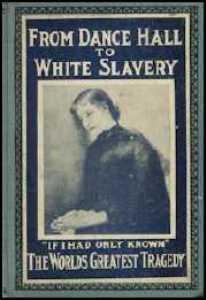Each is liable to panic, which is exactly the terror of ignorance surrendered to the imagination. - Ralph Waldo Emerson
I have written before that individual moral panics tend to last roughly twenty years at most, and that is true; however, it is also true that the cultural conditions which favor certain types of moral panics over others can be extremely long-lived. For example, though individual periods of witch-hunting typically lasted less than 20 years, the era in which they were extremely common lasted from the late 15th century to the mid-18th. There were other (non witch-related) moral panics during that time, such as the syphilis panic of the early 16th century; there were also witch-hunts throughout history outside of that era. But for various sociological reasons (not the least of which was the Protestant Reformation and the religious climate which gave rise to it), witch hunts were the most common and characteristic moral panics of that time.
 Similarly, the Victorian Era is noted for sex panics; again, there are many reasons, but the largest one is probably the ascendance of the middle class due to the Industrial Revolution, and the subsequent urbanization of the working class which placed its members within the sight of the bourgeoisie, from whom they had been relatively isolated for centuries. From about 1840 on the middle class became increasingly alarmed by the sexual freedom of the working class; they feared “moral contamination” and demanded that the masses submit to the same self-denial and rigid social structure as their “betters”. And though the weapons they developed to fight “vice” were ostensibly intended for sexual minorities such as whores and homosexuals, they were also freely employed against women who violated the increasingly-strict social controls on female sexual behavior. The sex panics waxed and waned, flowing into one another throughout the 19th century, finally culminating in the white slavery hysteria and anti-prostitution campaigns which resulted in the establishment of prohibitionist policies throughout the West, most especially in the United States. Eventually, the First World War in Europe and the Great Depression in the US put an end to the anti-sex climate; people had more important things to worry about, and the increasing freedom of women had helped the rising young generation to develop a healthier attitude about it than that of their parents and grandparents. From start to finish, the whole process took about 70 years, but signs of decay were clearly visible by the ‘90s; in other words, a clever sociologist might have been able to predict the eventual end of the sickness a generation before it finally came.
Similarly, the Victorian Era is noted for sex panics; again, there are many reasons, but the largest one is probably the ascendance of the middle class due to the Industrial Revolution, and the subsequent urbanization of the working class which placed its members within the sight of the bourgeoisie, from whom they had been relatively isolated for centuries. From about 1840 on the middle class became increasingly alarmed by the sexual freedom of the working class; they feared “moral contamination” and demanded that the masses submit to the same self-denial and rigid social structure as their “betters”. And though the weapons they developed to fight “vice” were ostensibly intended for sexual minorities such as whores and homosexuals, they were also freely employed against women who violated the increasingly-strict social controls on female sexual behavior. The sex panics waxed and waned, flowing into one another throughout the 19th century, finally culminating in the white slavery hysteria and anti-prostitution campaigns which resulted in the establishment of prohibitionist policies throughout the West, most especially in the United States. Eventually, the First World War in Europe and the Great Depression in the US put an end to the anti-sex climate; people had more important things to worry about, and the increasing freedom of women had helped the rising young generation to develop a healthier attitude about it than that of their parents and grandparents. From start to finish, the whole process took about 70 years, but signs of decay were clearly visible by the ‘90s; in other words, a clever sociologist might have been able to predict the eventual end of the sickness a generation before it finally came.
Those of my readers old enough to remember the 1970s know, as my younger readers may not, that the current climate of sex hysteria only began about 1980; the major reasons were religious backlash against the sexual revolution, cultural backlash against the increasing freedom of women, panics about rape and child sexual abuse purposefully stoked by organized feminism for political reasons, and of course the specter of AIDS (which brought all the other threads together). Though there have been other moral panics in the past 33 years, all of the major ones were about sex and most of those which weren’t directly about it were at least tangential. The most important hysteria of the early ‘80s, child sex abuse hysteria, split into two closely-related panics by the late ‘80s: the Satanic Panic and the child predator panic. The original feminist narrative of the hysteria, that huge numbers of women had been sexually abused by their evil fathers, brothers, uncles or whatever, proved too uncomfortable for Americans to embrace for very long, so it was externalized; the abusers were no longer family members but lust-crazed “pedos” or Satanists lurking in day-care centers (a venue whose implications for rapidly-growing numbers of women working outside the home should be obvious). These twin terrors went forth into other Western countries, and though the Satanic Panic eventually metamorphosed into “sex trafficking” hysteria, the “child predator” panic has only expanded as governments have recognized its utility as a tool of social control. The definition of “child” has rapidly expanded over the past twenty years to include young adults (thus pathologizing relationships which were perfectly normal throughout human history), and that of “sexual abuse” to include drawings or words about sex with or between younger people, not to mention non-sexual photographs of children of a type common in virtually every single family album in the Western world prior to the advent of the panic.
I’ve written elsewhere about increasing signs of decay in the “trafficking” hysteria, and now I’m pleased to call attention to similar signs of illness in its twin sister. Both panics have proven useful to governments: “trafficking” for border control and whore-persecution, and “child predator” as a means of abrogating privacy, expanding legal definitions of “harm” and relegating increasing numbers of non-violent citizens to pervasive control and surveillance. And because of this, governments (especially the US government) have dumped astronomical sums into promoting, encouraging and enforcing laws rooted in both of them. But though this sponsorship has extended both beyond their natural life-spans, it has also sowed the seeds of their destruction; the incredible heavy-handedness which characterizes government involvement in anything has begun to make the problems with these narratives more obvious even to those unaccustomed to critical thought. Articles criticizing the hysteria over “child porn” have begin to appear in the mainstream media, and though bloggers have been writing about the tyranny of “sex offender” registries for years, even those who are politically invested in them are beginning to take note:
the incredible heavy-handedness which characterizes government involvement in anything has begun to make the problems with these narratives more obvious even to those unaccustomed to critical thought. Articles criticizing the hysteria over “child porn” have begin to appear in the mainstream media, and though bloggers have been writing about the tyranny of “sex offender” registries for years, even those who are politically invested in them are beginning to take note:
…Since the Wetterling Act was passed in 1994, laws governing sex offenders have grown successively stricter and more far reaching. In many places, residency restrictions dictate that sex offenders cannot live within a certain distance from…places where children gather. Online registries broadcast the names and pictures of offenders, often without specifying the nature of their offenses. Juveniles treated as adults and labeled as sex offenders for acts involving other kids bear that stigma well into adulthood…The laws tend to fuel the impression that sex offenders are a uniform class of creepy strangers lurking in the shadows who are bound to attack children over and over again. That’s what [Patty Wetterling, mother of the namesake of the mandatory registration law] used to believe…too. Yet over the course of two decades…she found her assumptions slowly chipped away…she learned that abductions like Jacob’s are extremely rare, and that 90 percent of sexual offenses against children are committed by family members or acquaintances …[and] they…have a distinctly low recidivism rate…According to Human Rights Watch, at least 28 states require registration for consensual sex between teenagers, 13 for public urination, 32 for exposing genitals in public, and five for soliciting adult prostitutes. Restricting where sex offenders can live, in many cases forcing them into homelessness and disconnecting them from family and social support, hasn’t had any quantifiable reduction on the rate of sexual abuse…Wetterling…[has] quietly emerged as perhaps the most unlikely voice questioning sex offender laws…and…has expressed gnawing doubts over the past several years about how we deal with sex offenders…
But while politicians were only too happy to listen to Wetterling when she supported more laws, they’re not so eager to pay attention to her misgivings now. Still, a very few of them have apparently begun to recognize that the hysteria has gone too far; while most states have subscribed to the delusional argument that the registries are somehow not a form of punishment despite the fact that any child could see that they are, a Maryland court has taken a baby step in the right direction by ruling that “requiring an individual to register as a sex offender for a crime committed 12 years before the registry came into existence violates the Maryland Bill of Rights and the ex-post facto clause of the Federal Constitution”:
The prohibition against ex post facto laws is rooted in a basic sense of fairness, namely that a person should have “fair warning” of the consequences of his or her actions and that a person should be protected against unjust, oppressive, arbitrary, or vindictive legislation…Based on [these] principles…retrospective application of the sex offender registration statute…is unconstitutional.
 This decision is little more than erecting an umbrella against an avalanche, but it does represent a very small sign of shifting attitudes. It is not by any means the beginning of the end; we’re still a long way from the end of the “child predator” panic and an even longer way from the end of this anti-sex era in history. But once it’s clear that “sex trafficking” hysteria is beginning to collapse and the laws governing “sex offenders” aren’t getting any worse, we’ll at least be able to say that we’re at the end of the beginning.
This decision is little more than erecting an umbrella against an avalanche, but it does represent a very small sign of shifting attitudes. It is not by any means the beginning of the end; we’re still a long way from the end of the “child predator” panic and an even longer way from the end of this anti-sex era in history. But once it’s clear that “sex trafficking” hysteria is beginning to collapse and the laws governing “sex offenders” aren’t getting any worse, we’ll at least be able to say that we’re at the end of the beginning.
